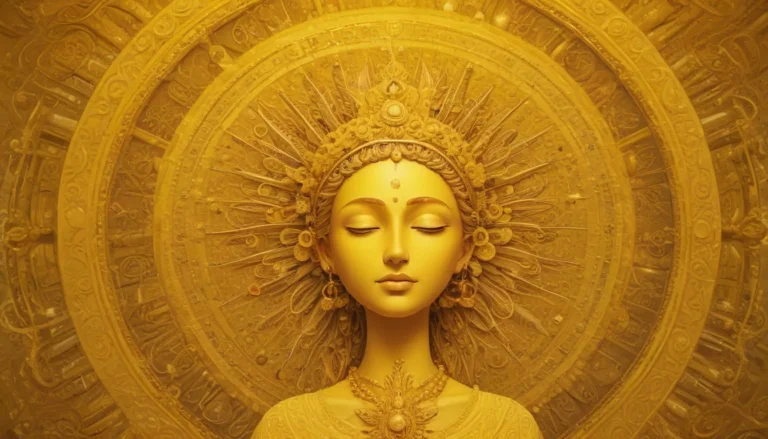
Are you curious about the spiritual meaning of colors? You’ve come to the right place! In this comprehensive guide, we will explore the significance of green – a color that symbolizes growth, renewal, and balance. We’ll delve into the cultural, religious, and psychological aspects of green while offering practical tips on how you can harness its power in your daily life. So, let’s dive right in!
What Does Green Symbolize?
Green is a versatile color that symbolizes various concepts depending on the context. Here are some of its key associations:
-
Nature and growth – Green is often associated with plants, trees, grass, and other natural elements. It signifies growth, vitality, and renewal, reminding us of the cyclical nature of life.
-
Harmony and balance – The color green represents equilibrium in many cultures. It’s a reminder to seek harmony within ourselves, our relationships, and the environment.
-
Money and prosperity – Green is also linked to wealth, abundance, and financial success. In some cultures, it’s believed that possessing green objects or wearing green clothes can attract good fortune.
-
Health and well-being – The color green is associated with healing, vitality, and the human body. It encourages us to prioritize self-care, make healthier choices, and maintain a balanced lifestyle.
-
Emotional healing – Green is a soothing color that promotes emotional well-being. Its calming energy can help reduce stress, anxiety, and depression while fostering compassion and understanding.
Cultural Significance of the Color Green
Throughout history, different cultures have assigned unique meanings to green. Here are some notable examples:
-
Ancient Egypt – In ancient Egyptian culture, green represented fertility, rebirth, and renewal. It was closely associated with the goddess Isis, who was known as the mother of all things living.
-
Islam – In Islamic art and architecture, green is considered a sacred color, representing paradise, eternity, and divine guidance. The Prophet Muhammad’s favorite color was green, and it’s often used in mosques and religious texts.
-
Christianity – Green holds different meanings in Christianity. It can symbolize growth, hope, and new beginnings, especially during Easter and Advent seasons. Additionally, some Christian traditions associate green with the Holy Spirit and the Virgin Mary.
-
Buddhism – In Buddhist culture, green represents enlightenment, wisdom, and the healing powers of nature. It’s also associated with the heart chakra, which is linked to love, compassion, and emotional balance.
-
Irish Mythology – In Celtic mythology, green represents life force energy, rebirth, and magic. The color was sacred to the goddess Danu, who was considered the mother of all Irish gods and goddesses.
Spiritual Practices Involving Green
To harness the power of green in your spiritual journey, consider incorporating these practices into your daily routine:
-
Meditate with green crystals – Certain crystals have a strong connection to the color green. Examples include emeralds, jadeite, and malachite. Holding or meditating with these stones can help you tap into their healing energies.
-
Surround yourself with nature – Spending time in natural environments like forests, parks, or gardens can help you absorb the positive energy of green. Try to incorporate more plants and greenery into your living space for a calming atmosphere.
-
Incorporate green clothing and accessories – Wearing green or using green-colored items such as scarves, jewelry, or even make-up can enhance your connection to this color’s spiritual meaning.
-
Practice gratitude – Green symbolizes abundance and prosperity, so take a moment each day to express gratitude for all the blessings in your life. This simple practice can help shift your energy towards attracting more positivity.
-
Create green-themed art or mandalas – Artistic expressions are powerful tools for connecting with the spiritual realm. Drawing or painting green images can help you tap into its healing energies and promote emotional well-being.
The Color Green in Psychology
Researchers have found that exposure to the color green has several psychological benefits, including:
-
Reduced stress – Studies show that green environments can significantly reduce stress levels, lower blood pressure, and improve overall mood. This is why spending time outdoors or incorporating more greenery into your living space can be therapeutic.
-
Enhanced creativity – Green is known to stimulate cognitive function and creativity. It’s a great color for brainstorming sessions or creative projects, as it encourages open-minded thinking and problem-solving.
-
Improved focus – The color green can help you stay focused on tasks by reducing mental fatigue and increasing attention span. This makes it an excellent choice for workspaces or study areas.
-
Better decision-making – Green is associated with balance, harmony, and growth. When making important decisions, consider using green as a reminder to seek equilibrium and consider all aspects of the situation.
-
Emotional stability – Incorporating more green into your life can help promote emotional stability by fostering feelings of calmness, tranquility, and contentment.
Final Thoughts
The spiritual meaning of the color green is vast and multifaceted, encompassing nature, growth, harmony, and balance. By understanding its cultural significance, psychological benefits, and practical applications, you can harness its power to promote well-being, attract abundance, and live a more balanced life. So go ahead – surround yourself with green, both literally and figuratively, and see how it transforms your world!





